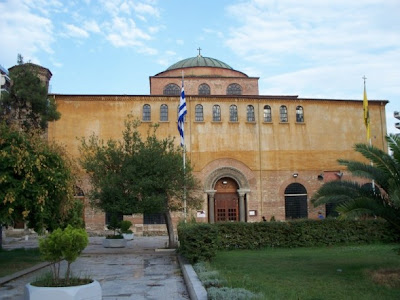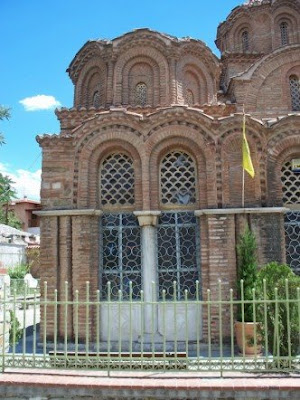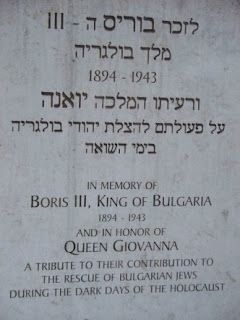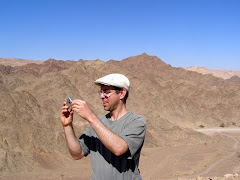Galerius' Rotunda of St. George (Galerius' Tomb)

This transformation from tomb to church involved the addition of a sancturary as an extention of the east bay of the rotunda (shown here protruding towards the photographer from the cylinder-shaped building). There are supports at each side of the apse which were added after an earthquake.
The uniqueness of this church's form is due to it's having been built as a tomb and only later made into a church. The tomb was to be for the Roman ruler Galerius--who was involved in Roman leadership during the Tetrarchy that began with Diocletian and ended with Constantine.
Galerius spent a lot of time in Thessaloniki between 299 and 303 c.e. and had his palace in the city as well an arch dedicated to his having defeated the Persians around 298 c.e. These remains are archaeological highlights of Thessaloniki today. Galerius didn't die there as he seems to have planned on doing so the tomb lay empty until the Emperor Constantine ordered that the empty tomb be converted into a church dedicated to the Archangels.
Galerius spent a lot of time in Thessaloniki between 299 and 303 c.e. and had his palace in the city as well an arch dedicated to his having defeated the Persians around 298 c.e. These remains are archaeological highlights of Thessaloniki today. Galerius didn't die there as he seems to have planned on doing so the tomb lay empty until the Emperor Constantine ordered that the empty tomb be converted into a church dedicated to the Archangels.

This transformation from tomb to church involved the addition of a sancturary as an extention of the east bay of the rotunda (shown here protruding towards the photographer from the cylinder-shaped building). There are supports at each side of the apse which were added after an earthquake.
Later, Christians added mosaics to the building. The apse is decorated with a 9th century fresco of the Ascension. The interior of the highest drum before the dome features mosaics interspersed with now enclosed windows. This is explained as having been an architectural feature that allowed significant amount of light to illuminate the gold on the mosaics and interior of the dome.
This church was interesting for me because I have read that the octogonal churches in the Holy Land that usually mark a holy site (such as Capernaum, the original Churches of the Holy Sepulcre and original Church of the Nativity among others) are modeled after Roman emperors' tombs. In this case, it may have simply been that a monument was available and Constantine, having recently adopted Christianity, decided to put the building to use.
Hagia Sofia (Holy Wisdom)
The Church of the Prophet Elijah
 The Church of the Prophet Elijah's compact structure shares common features of later Byzantine church design but is also an example of a unique type. The lateral apses were added in order to provide space for monastic choirs. This design is "limited to Mount Athos, where about twenty examples are preserved, and to related areas in Northern Greece and in the Balkans" (Ousterhout, 29 note 40).
The Church of the Prophet Elijah's compact structure shares common features of later Byzantine church design but is also an example of a unique type. The lateral apses were added in order to provide space for monastic choirs. This design is "limited to Mount Athos, where about twenty examples are preserved, and to related areas in Northern Greece and in the Balkans" (Ousterhout, 29 note 40).
The 5th century Hagia Sofia church was inspired by the famous church with the same name in Constantinople / Istanbul. It may be that Thessaloniki's Hagia Sofia is a copy of the church in Constantinople that was destroyed before the larger Hagia Sofia was built by Justinian in the 6th century. Still, Thessaloniki's Hagia Sofia has features that serve as reminds of the renowned Hagia Sofia. First, there is a dome in the center with supporting pilars. The marble of the Constantinople's Hagia Sofia that stands out is maroon, deep green, and deep green and the walls in Thessaloniki's version are painted in the same tones. The upper gallery of the Hagia Sofia in Istanbul is painted in a dirty yellow with floral designs and Thessaloniki's exterior is a similar color. Finally, both Istanbul and Thessaloniki's Hagia Sofia churches are in a domed Basilica style.
in Thessaloniki's version are painted in the same tones. The upper gallery of the Hagia Sofia in Istanbul is painted in a dirty yellow with floral designs and Thessaloniki's exterior is a similar color. Finally, both Istanbul and Thessaloniki's Hagia Sofia churches are in a domed Basilica style.
The Saint Demetrios Church is an early Byzantine Basilica (without a dome) and also dates from teh 5th century. Although a reconstruction after having been destroyed in a fire in the 20th century, the Saint Demetrios Church is interesting for it's once standard 5 aisle form. Details such as columns and capitals from the original building and the crypt give the church a feeling of uniqueness. The crypt was part of a Roman bath-house.
These 5th century Basilicas served were designed for the processional liturgy of the early Byzantine church. Such events could involved thousands of worshippers who moved around within the building.
St. Katherine's Church & The Church of the Holy Apostles
 Encountering St. Katherine's Church (pictured here) and The Church of the Holy Apostles lifted my Thessaloniki Byzantine church tour from the level of energetic intellectual curiousity to absorbed aesthetic appreciation. I first encountered The Church of the Holy Apostles when my companions had had enough and went back to the hostel to put in some time at the beach. I calculated that being done for the day would make it nearly impossible to hit all the listed Byzantine Churches so I stayed in town for an uncharacteristicly late evening.
Encountering St. Katherine's Church (pictured here) and The Church of the Holy Apostles lifted my Thessaloniki Byzantine church tour from the level of energetic intellectual curiousity to absorbed aesthetic appreciation. I first encountered The Church of the Holy Apostles when my companions had had enough and went back to the hostel to put in some time at the beach. I calculated that being done for the day would make it nearly impossible to hit all the listed Byzantine Churches so I stayed in town for an uncharacteristicly late evening.
I don't know what it is about these two churches that struck my aesthetic chord. As an observer or art, it's rare that I experience the sublime level of appreciation until after I've studied something pretty thoroughly--I reached that point with the exterior of Byzantine churches after chasing down quite a number of them and reading some brief commentaries about features from different periods. Most of my reading about things Byzantine is about emperors and diplomatic and religious issues.
Both of the churches were both built in the early 14th century, during the Palaiologan dynasty near the end of the Byzantine Empire. These are "cross-in-square" churches, which were "dominant in [late] Byzantine ecclesiastical architecture until the close of the Middle Ages ... The idea was very simple and based entirely on structural elements deeply rooted in the Byzantine tradition: that of a dome rising above four barrel vaults, arranged so as to form a Greek cross." This type of church was small and "designed ... to hold a congregation of about one hundred ... the cross-in-square church arose in a monastic milieu. A Byzantine monestary normally numbered a brotherhood of between twenty and one hundred" (Mango, Cyril. Byzantine Architecture, 178). These churches were used for more private worship involving individual prayer and the interaction between the worshipper and icons. This type of worship lead to churches having numerous small spaces including private chapels (Ousterhout, Master Builders of Byzantium, 9-10).

The structure of the two churches is similar--they have five domes with the central and corner domes being nearly the same size. The height of the relatively small domes above the roof creates room for windows with stepped arches around small windows. I think this is what makes the exterior so appealing to me. In addition, each of the churches had appealing unique features: The Church of the Holy Apostles has decorative brickwork on its exterior while the St. Katherine's Church has double and triple openings on the facade.
The interior design of the churches of this period draw praise from art commentators but I wasn't too absorbed by this, although I have been in various of Istanbul's Byzantine churches.  in Thessaloniki's version are painted in the same tones. The upper gallery of the Hagia Sofia in Istanbul is painted in a dirty yellow with floral designs and Thessaloniki's exterior is a similar color. Finally, both Istanbul and Thessaloniki's Hagia Sofia churches are in a domed Basilica style.
in Thessaloniki's version are painted in the same tones. The upper gallery of the Hagia Sofia in Istanbul is painted in a dirty yellow with floral designs and Thessaloniki's exterior is a similar color. Finally, both Istanbul and Thessaloniki's Hagia Sofia churches are in a domed Basilica style.The Saint Demetrios Church is an early Byzantine Basilica (without a dome) and also dates from teh 5th century. Although a reconstruction after having been destroyed in a fire in the 20th century, the Saint Demetrios Church is interesting for it's once standard 5 aisle form. Details such as columns and capitals from the original building and the crypt give the church a feeling of uniqueness. The crypt was part of a Roman bath-house.
These 5th century Basilicas served were designed for the processional liturgy of the early Byzantine church. Such events could involved thousands of worshippers who moved around within the building.
St. Katherine's Church & The Church of the Holy Apostles
 Encountering St. Katherine's Church (pictured here) and The Church of the Holy Apostles lifted my Thessaloniki Byzantine church tour from the level of energetic intellectual curiousity to absorbed aesthetic appreciation. I first encountered The Church of the Holy Apostles when my companions had had enough and went back to the hostel to put in some time at the beach. I calculated that being done for the day would make it nearly impossible to hit all the listed Byzantine Churches so I stayed in town for an uncharacteristicly late evening.
Encountering St. Katherine's Church (pictured here) and The Church of the Holy Apostles lifted my Thessaloniki Byzantine church tour from the level of energetic intellectual curiousity to absorbed aesthetic appreciation. I first encountered The Church of the Holy Apostles when my companions had had enough and went back to the hostel to put in some time at the beach. I calculated that being done for the day would make it nearly impossible to hit all the listed Byzantine Churches so I stayed in town for an uncharacteristicly late evening.I don't know what it is about these two churches that struck my aesthetic chord. As an observer or art, it's rare that I experience the sublime level of appreciation until after I've studied something pretty thoroughly--I reached that point with the exterior of Byzantine churches after chasing down quite a number of them and reading some brief commentaries about features from different periods. Most of my reading about things Byzantine is about emperors and diplomatic and religious issues.
Both of the churches were both built in the early 14th century, during the Palaiologan dynasty near the end of the Byzantine Empire. These are "cross-in-square" churches, which were "dominant in [late] Byzantine ecclesiastical architecture until the close of the Middle Ages ... The idea was very simple and based entirely on structural elements deeply rooted in the Byzantine tradition: that of a dome rising above four barrel vaults, arranged so as to form a Greek cross." This type of church was small and "designed ... to hold a congregation of about one hundred ... the cross-in-square church arose in a monastic milieu. A Byzantine monestary normally numbered a brotherhood of between twenty and one hundred" (Mango, Cyril. Byzantine Architecture, 178). These churches were used for more private worship involving individual prayer and the interaction between the worshipper and icons. This type of worship lead to churches having numerous small spaces including private chapels (Ousterhout, Master Builders of Byzantium, 9-10).

The structure of the two churches is similar--they have five domes with the central and corner domes being nearly the same size. The height of the relatively small domes above the roof creates room for windows with stepped arches around small windows. I think this is what makes the exterior so appealing to me. In addition, each of the churches had appealing unique features: The Church of the Holy Apostles has decorative brickwork on its exterior while the St. Katherine's Church has double and triple openings on the facade.
The Church of the Prophet Elijah
The Church of the Prophet Elijah was the surprise of my visit. I had read about Mt. Athos and the style of church that is typical there and was pleased to find that such a church was on display in Thessaloniki. Like St. Katherines and the Church of the Holy Apostles, this church was built in the later Byzantine period which featured small churches built for monastic groups.
 The Church of the Prophet Elijah's compact structure shares common features of later Byzantine church design but is also an example of a unique type. The lateral apses were added in order to provide space for monastic choirs. This design is "limited to Mount Athos, where about twenty examples are preserved, and to related areas in Northern Greece and in the Balkans" (Ousterhout, 29 note 40).
The Church of the Prophet Elijah's compact structure shares common features of later Byzantine church design but is also an example of a unique type. The lateral apses were added in order to provide space for monastic choirs. This design is "limited to Mount Athos, where about twenty examples are preserved, and to related areas in Northern Greece and in the Balkans" (Ousterhout, 29 note 40).
Thinking about Byzantine Churches in Thessaloniki brought me an appreciation of the last period of Byzantine: the Palaiologan Dynasty (previously, my interest in Byzantine had focused on the early period when the Byzantine Empire was much stronger and when the creeds were crafted). It turns out that the Palaiologan period was the high point of Byzantine art--and is said to have influenced, or even sparked, the Italian renaissance.




















